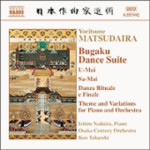
Matsudaira: Bugaku Dance Suite / Theme and Variations for Piano and Orchestra
 $25.00
Low Stock
add to cart
$25.00
Low Stock
add to cart
YORITSUNE MATSUDAIRA
Matsudaira: Bugaku Dance Suite / Theme and Variations for Piano and Orchestra
Osaka Century Orchestra, Ken Takaseki
[ Naxos / CD ]
Release Date: Monday 25 September 2006
Should this item be out of stock at the time of your order, we would expect to be able to supply it to you within 4 - 7 business days.
Yoritsune Matsudaira is descended from the Shogun family who ruled over Japan from 1603 to 1867, based in Edo, later changed to Tokyo.
The family name of the Shogun was originally Matsudaira, and only a limited number of people, who possessed the right of inheriting the shogunate, were allowed to use the name Tokugawa. Yoritsune's direct ancestry was from Yorifusa Tokugawa, the first Shogun's eleventh son, who lived in Hitachi-Fuchu, north-east of Edo. When the Shogun regime came to an end, the imperial family, who had practically been deprived of powers and had existed only as a dignified religious and spiritual symbol, returned to the forefront of politics for the first time in six hundred years. Japan's rapid westernisation and modernisation under the Emperor naturally involved a drastic change in the life of the Shogun family. Matsudaira's estate in Hitachi-Fuchu was confiscated by the new government and the head of the family, Yoritsune's grandfather, was given the title of viscount in return, following the newly introduced aristocracy, modelled on the European system. The next head of the family, Yoritaka Matsudaira, Yoritsune's father, served the Emperor as manager of the hunting field and was to leave behind a reputation as an ornithologist and a collector of rare stuffed birds.
Yoritsune Matsudaira was born in Tokyo on 5th May 1907, the first son of the "Viscount of Birds" and heir to the title. On his mother's side he was descended from the Fujiwara family, who had been the most powerful nobility at the imperial court from the seventh to the twelfth century and practically governed Japan. These surroundings imbued him with a peculiar character. He loved artificial things, partly because he grew up surrounded by stuffed birds, and he detested every kind of nationalistic element, because he had spent his childhood between 1910 and 1920, when individualism and liberalism were in fashion, a reaction against the nationalism prevalent since the Sino- Japanese and the Russo-Japanese Wars. Repelled by militarism, aristocracy, heroism and Japanese conventional homogeneity and collectivism, he even refused to wear a uniform at elementary school. He regarded romanticism and sentimentalism as his hypothetical enemy; he never accepted the priority of emotions over theories, sensuality over artificiality and collective solidarity over individuals. Studying the French language under French teachers at Gyosei High School, which was founded by a French Catholic order, he became more and more interested in French culture, which further fostered his unique character.
Tracks:
Theme and Variations for Piano and Orchestra
Danza Rituale e Finale (Enbou)
Sa-Mai
U-Mai (Danza antica nello stile della Corte Giapponese)
Danza Rituale e Finale (Chogeishi)